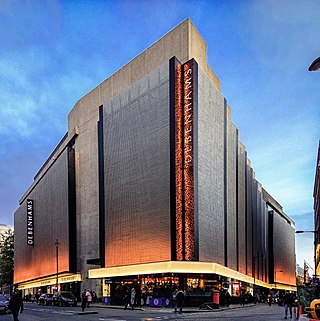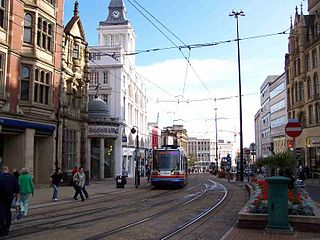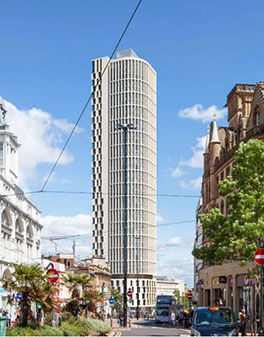
Debenhams plc was a British department store chain operating in the United Kingdom, Denmark and the Republic of Ireland, and is still operating as a franchise in seven Middle East countries. It was founded in 1778 as a single store in London and grew to 178 locations across those countries, also owning the Danish department store chain Magasin du Nord. In its final years, its headquarters were within the premises of its flagship store in Oxford Street, London. The range of goods sold included middle-to-high-end clothing, beauty, household items, and furniture.

Allders was an independent department store operating in the United Kingdom.

Robert Sayle was the founder of a department store located in Cambridge.
John Walsh was a family-owned department store in Sheffield, South Yorkshire, England.
Bonds of Norwich was a department store based in All Saints Green, Norwich, England. John Lewis Partnership purchased the business in 1982. The store was renamed John Lewis in 2001.

John Lewis & Partners is a British brand of high-end department stores operating throughout the United Kingdom, with concessions also located in Ireland. The brand sells general merchandise as part of the John Lewis Partnership. It was created by Spedan Lewis, son of the founder, John Lewis, in 1929. From 1925 to 2022, the chain had a policy that it would always at least match a lower price offered by a national high street competitor; this pledge was known by the name "Never Knowingly Undersold".

Sheffield City Centre is a district of the City of Sheffield and is covered partly by the City ward of the City of Sheffield. It includes the area that is within a radius of roughly 0.75 miles (1.2 km) of Sheffield Cathedral and is encircled by the Inner Ring Road, a circular route started in the late 1960s and completed in 2007. As well as the cathedral, buildings in the city centre include the Grade I listed Town Hall, the City Hall and the Winter Gardens. Several areas of the city centre have been designated as quarters. It is home to the city's major business, transport, leisure and cultural attractions.

High Street is one of the main thoroughfares and shopping areas in the city centre of Sheffield in South Yorkshire, England, located at the approximate grid reference of SK356874. High Street starts at the Commercial Street, Fitzalan Square and Haymarket junction and runs for approximately 400 metres west to conclude near the Sheffield Cathedral where it forms a Y-junction with Fargate and Church Street. High Street has the traditional wide variety of shops, financial institutions and eating places which are associated with any British town centre.

The Moor Quarter is one of Sheffield's twelve designated quarters, built around and named for The Moor, a pedestrianised thoroughfare. It is bound by Furnival Gate in the north-east, Eyre Street in the south-east, St Mary's Gate to the south, and Moore Street and Charter Row to the north-west.

McWhirters is a heritage-listed former department store at Wickham Street, Fortitude Valley, City of Brisbane, Queensland, Australia. It is also known as McWhirters Marketplace, McWhirters & Son Ltd, and Myer. It was added to the Queensland Heritage Register on 21 October 1992.

Bradbeers is a family run chain of department and furniture stores with branches in Salisbury, New Milton, Hedge End and Romsey. It has been running in Hampshire for over 175 years. The origins of the business stem back to a small drapery shop in Southampton run by R. S. Smith. The store traded under various names until 1892 when Mr Bradbeer entered the business. The shop was destroyed during the bombing of Southampton during World War II, and the firm ceased trading in the city. Today, the business operates from four main sites with department stores in Romsey and New Milton and furniture stores in both New Milton and Hedge End.
Edwin Jones was a large department store in Southampton, England founded in 1860 in East Street, Southampton with further stores established in Old Christchurch Road, Bournemouth, and Clinton Arcade, Weymouth. The business became part of the Drapery Trust, later a subsidiary of Debenhams, in 1928. The store was re-branded as Debenhams in 1973.

Barkers of Kensington was a department store in Kensington High Street, Kensington, London. It began as a small drapery business, John Barker & Company, founded by John Barker and James Whitehead in 1870. Barkers grew rapidly to become one of London's largest and most well-known department stores.
Keddies was a small chain of department stores in Essex, England, with its flagship store in a prime location in Southend High Street. The business had a national reputation, being recognised in The Fashion Handbook, appearing on the side of a Matchbox model 17C bus and being one of the retailers that fought to remove Retail Price Maintenance. Keddies closed for business on 26 February 1996 after going into administration.
Bobby & Co. was a provincial department store group based mainly in seaside towns on the south coast of England. The business operated from 1887 until 1972. During the 1920s it became part of the Drapery Trust, which in turn became a subsidiary of Debenhams.

Peter Robinson was a chain of department stores with its flagship store being situated at Oxford Circus, London. Founded in 1833 as a drapery, Robinson bought up nearby shops on Oxford Street to create a department store. The Topshop chain debuted in 1964 as a section in a Peter Robinson branch. The shop building in Oxford Circus was completed in 1912 and is Grade II listed.

Colson's, later Dingle's and House of Fraser, was a department store located in Exeter, Devon, England. Located on the High Street, the store was founded in 1792, then expanded after damage in the Second World War. It was later purchased and grouped with Plymouth-based Dingles, taking their name, before becoming House of Fraser. The store closed in 2019, along with a number of other House of Fraser stores during financial difficulties at the group. The site was derelict for a number of years, before being renovated during 2022 by IHG Hotels & Resorts as a Hotel Indigo, including a restaurant named "Colson's" in recognition of the history of the building.
Hanningtons was a department store located in the English coastal city of Brighton and Hove. Prominently situated in a central position in Brighton, it had an unbroken history of trading for nearly 200 years until its closure in 2001. It was the city's oldest, largest and most diverse department store: its 70 departments offered clothes and household goods of all types, and services ranging from funeral arrangement to carpet-cleaning. "Famous" and "prestigious", it was known locally as the "Harrods of Brighton". It remained in family ownership until the 1960s, and subsequent owners ran the business according to the principles of the Hannington family.
William Lefevre was a department store located in Canterbury, which later became part of Debenhams.

Kings Tower is an approved skyscraper that will be located on Castle Square at the junction of High Street and Angel Street in Sheffield, South Yorkshire. With a planned height of 120 m (390 ft) once completed, Kings Tower will overtake Code Sheffield, and St Pauls Tower as the tallest building in Sheffield and in Yorkshire. Plans for the tower were submitted by architects Hodder + Partners in September 2020, calling initially for a 39-storey tower. Planning permission was granted in December 2020, and construction is planned to complete in 2023. Amended plans were submitted in late 2022, adding a 40th floor to the project.













